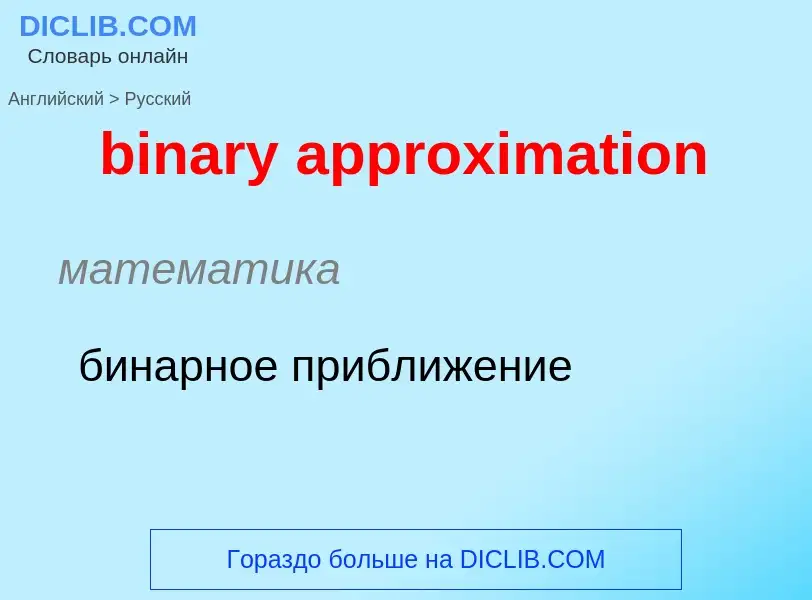Перевод и анализ слов искусственным интеллектом ChatGPT
На этой странице Вы можете получить подробный анализ слова или словосочетания, произведенный с помощью лучшей на сегодняшний день технологии искусственного интеллекта:
- как употребляется слово
- частота употребления
- используется оно чаще в устной или письменной речи
- варианты перевода слова
- примеры употребления (несколько фраз с переводом)
- этимология
binary approximation - перевод на русский
математика
бинарное приближение
['bainəriɔpɔ'ziʃ(ə)n]
лингвистика
бинарная оппозиция
астрономия
двойная затмевающаяся
затменно-двойная (о планете)
Определение
Википедия

In mathematics, approximation theory is concerned with how functions can best be approximated with simpler functions, and with quantitatively characterizing the errors introduced thereby. Note that what is meant by best and simpler will depend on the application.
A closely related topic is the approximation of functions by generalized Fourier series, that is, approximations based upon summation of a series of terms based upon orthogonal polynomials.
One problem of particular interest is that of approximating a function in a computer mathematical library, using operations that can be performed on the computer or calculator (e.g. addition and multiplication), such that the result is as close to the actual function as possible. This is typically done with polynomial or rational (ratio of polynomials) approximations.
The objective is to make the approximation as close as possible to the actual function, typically with an accuracy close to that of the underlying computer's floating point arithmetic. This is accomplished by using a polynomial of high degree, and/or narrowing the domain over which the polynomial has to approximate the function. Narrowing the domain can often be done through the use of various addition or scaling formulas for the function being approximated. Modern mathematical libraries often reduce the domain into many tiny segments and use a low-degree polynomial for each segment.


![cataclysmic variable system]] cataclysmic variable system]]](https://commons.wikimedia.org/wiki/Special:FilePath/Accretion Disk Binary System.jpg?width=200)
![The two visibly distinguishable components of [[Albireo]] The two visibly distinguishable components of [[Albireo]]](https://commons.wikimedia.org/wiki/Special:FilePath/Albireo.jpg?width=200)
![near-infrared H-band]], sorted according to orbital phase. near-infrared H-band]], sorted according to orbital phase.](https://commons.wikimedia.org/wiki/Special:FilePath/Algol AB movie imaged with the CHARA interferometer - labeled.gif?width=200)
![plasma ejection]]s from [[V Hydrae]] plasma ejection]]s from [[V Hydrae]]](https://commons.wikimedia.org/wiki/Special:FilePath/Artist's Illustration of Scenario for Plasma Ejections from V Hydrae.jpg?width=200)
![HD 106906]] HD 106906]]](https://commons.wikimedia.org/wiki/Special:FilePath/HD 106906 b imaged by SPHERE.jpg?width=200)
![Artist's impression of the binary star system [[AR Scorpii]] Artist's impression of the binary star system [[AR Scorpii]]](https://commons.wikimedia.org/wiki/Special:FilePath/This artist’s impression shows the strange object AR Scorpii.jpg?width=200)
![Artist's impression of the sight from a (hypothetical) moon of planet [[HD 188753 Ab]] (upper left), which orbits a [[triple star system]]. The brightest companion is just below the horizon. Artist's impression of the sight from a (hypothetical) moon of planet [[HD 188753 Ab]] (upper left), which orbits a [[triple star system]]. The brightest companion is just below the horizon.](https://commons.wikimedia.org/wiki/Special:FilePath/Triple-star sunset.jpg?width=200)
![[[Luhman 16]], the third closest star system, contains two [[brown dwarf]]s. [[Luhman 16]], the third closest star system, contains two [[brown dwarf]]s.](https://commons.wikimedia.org/wiki/Special:FilePath/Two Brown Dwarfs in Our Backyard.jpg?width=200)
